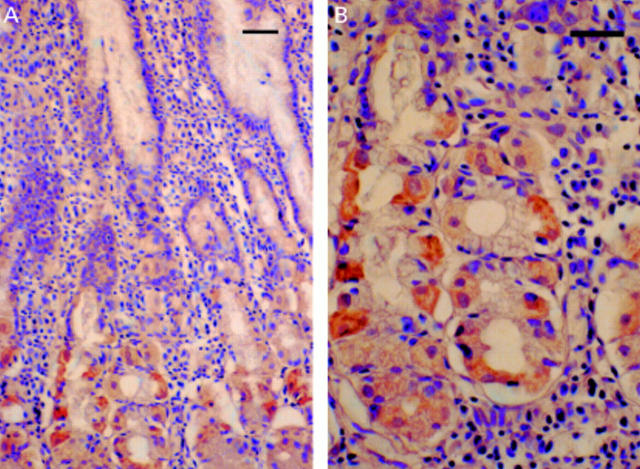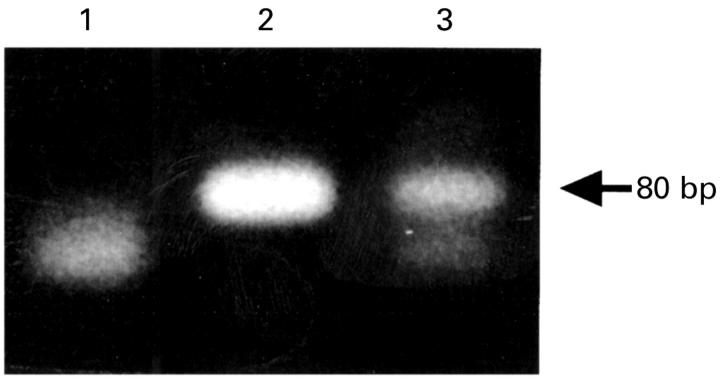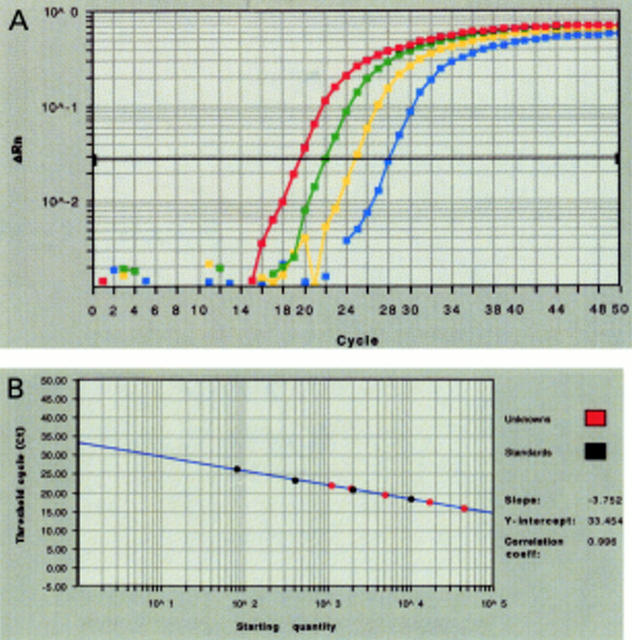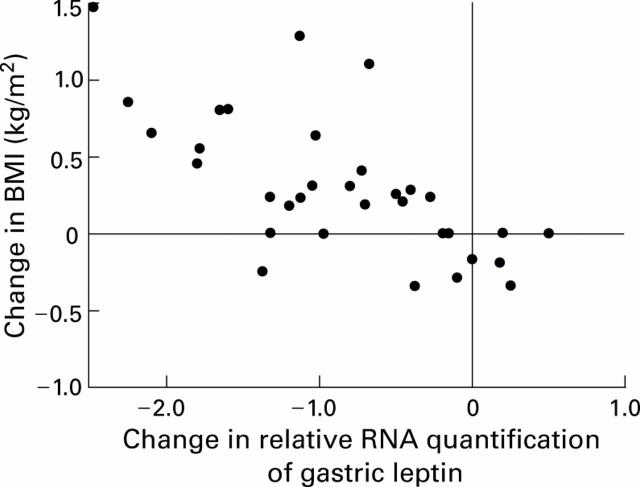Abstract
BACKGROUND—Leptin regulates feeding behaviour and therefore may be a mediator of anorexia associated with acute and chronic inflammation. Recently, leptin mRNA and leptin protein were found in the gastric epithelium. AIM—The aim of the present study was to examine the effect of Helicobacter pylori infection on gastric leptin expression to investigate the pathophysiological role of gastric leptin. METHODS—Surgically resected human stomach tissues were subjected to immunohistochemistry and reverse transcriptase-polymerase chain reaction (RT-PCR) to check for the presence of leptin in the human gastric epithelium. A total of 201 H pylori positive patients with chronic gastritis underwent eradication therapy for H pylori and were examined for the effect of infection cure in terms of body mass index (BMI) and serum leptin levels. Biopsy specimens from the gastric fundic mucosa were obtained from 40 of the 201 patients before and three months after eradication therapy. These samples were subjected to quantitative RT-PCR to examine the effect of eradication therapy on leptin expression in the gastric fundic mucosa. RESULTS—Leptin immunoreactive cells were detected in the lower half of the gastric fundic glands and a leptin PCR product was also found in the gastric fundic mucosa. H pylori infection significantly increased gastric leptin expression. In addition, cure of H pylori infection significantly reduced gastric leptin expression, with a concomitant increase in BMI. In contrast, serum leptin levels did not change significantly after cure of H pylori infection. CONCLUSION—Leptin is present in the human gastric mucosa. Gastric leptin may play a role in weight gain after eradication of H pylori infection. Gastric leptin may have a local rather than systemic action. Keywords: Helicobacter pylori; leptin; gastric mucosa; body mass index; gastritis
Full Text
The Full Text of this article is available as a PDF (238.0 KB).
Figure 1 .
Immunostaining of leptin in the human fundic mucosa. Leptin immunoreactivity was seen in the lower half of the fundic epithelial glands (A). Higher magnification (B). Scale bars 10 µm.
Figure 2 .
Reverse transcriptase-polymerase chain reaction analysis of leptin mRNA: negative control (lane 1), gastrocolic omentum (lane 2), and fundic mucosa (lane 3).
Figure 3 .
Relationship between the change in symptom score and change in body mass index (BMI). There was no significant correlation (r=0.10, p=0.189).
Figure 4 .
A calibration curve was constructed using four different dilutions of the mRNA obtained from the gastrocolic omentum. (A) Amplification plots of leptin; (B) calibration curve for leptin.
Figure 5 .
Relationship between the change in relative RNA quantification of gastric leptin and the change in body mass index (BMI). There was a significant correlation between the two (r=−0.69, p=0.0002).
Selected References
These references are in PubMed. This may not be the complete list of references from this article.
- Bado A., Levasseur S., Attoub S., Kermorgant S., Laigneau J. P., Bortoluzzi M. N., Moizo L., Lehy T., Guerre-Millo M., Le Marchand-Brustel Y. The stomach is a source of leptin. Nature. 1998 Aug 20;394(6695):790–793. doi: 10.1038/29547. [DOI] [PubMed] [Google Scholar]
- Bendtzen K. Interleukin 1, interleukin 6 and tumor necrosis factor in infection, inflammation and immunity. Immunol Lett. 1988 Nov;19(3):183–191. doi: 10.1016/0165-2478(88)90141-1. [DOI] [PubMed] [Google Scholar]
- Bornstein S. R., Preas H. L., Chrousos G. P., Suffredini A. F. Circulating leptin levels during acute experimental endotoxemia and antiinflammatory therapy in humans. J Infect Dis. 1998 Sep;178(3):887–890. doi: 10.1086/515349. [DOI] [PubMed] [Google Scholar]
- Campfield L. A., Smith F. J., Guisez Y., Devos R., Burn P. Recombinant mouse OB protein: evidence for a peripheral signal linking adiposity and central neural networks. Science. 1995 Jul 28;269(5223):546–549. doi: 10.1126/science.7624778. [DOI] [PubMed] [Google Scholar]
- Crabtree J. E., Shallcross T. M., Heatley R. V., Wyatt J. I. Mucosal tumour necrosis factor alpha and interleukin-6 in patients with Helicobacter pylori associated gastritis. Gut. 1991 Dec;32(12):1473–1477. doi: 10.1136/gut.32.12.1473. [DOI] [PMC free article] [PubMed] [Google Scholar]
- Faggioni R., Fantuzzi G., Fuller J., Dinarello C. A., Feingold K. R., Grunfeld C. IL-1 beta mediates leptin induction during inflammation. Am J Physiol. 1998 Jan;274(1 Pt 2):R204–R208. doi: 10.1152/ajpregu.1998.274.1.R204. [DOI] [PubMed] [Google Scholar]
- Fisher R. S., Parkman H. P. Management of nonulcer dyspepsia. N Engl J Med. 1998 Nov 5;339(19):1376–1381. doi: 10.1056/NEJM199811053391907. [DOI] [PubMed] [Google Scholar]
- Halaas J. L., Gajiwala K. S., Maffei M., Cohen S. L., Chait B. T., Rabinowitz D., Lallone R. L., Burley S. K., Friedman J. M. Weight-reducing effects of the plasma protein encoded by the obese gene. Science. 1995 Jul 28;269(5223):543–546. doi: 10.1126/science.7624777. [DOI] [PubMed] [Google Scholar]
- Heid C. A., Stevens J., Livak K. J., Williams P. M. Real time quantitative PCR. Genome Res. 1996 Oct;6(10):986–994. doi: 10.1101/gr.6.10.986. [DOI] [PubMed] [Google Scholar]
- Hsu S. M., Raine L., Fanger H. Use of avidin-biotin-peroxidase complex (ABC) in immunoperoxidase techniques: a comparison between ABC and unlabeled antibody (PAP) procedures. J Histochem Cytochem. 1981 Apr;29(4):577–580. doi: 10.1177/29.4.6166661. [DOI] [PubMed] [Google Scholar]
- Labenz J., Blum A. L., Bayerdörffer E., Meining A., Stolte M., Börsch G. Curing Helicobacter pylori infection in patients with duodenal ulcer may provoke reflux esophagitis. Gastroenterology. 1997 May;112(5):1442–1447. doi: 10.1016/s0016-5085(97)70024-6. [DOI] [PubMed] [Google Scholar]
- Ma Z., Gingerich R. L., Santiago J. V., Klein S., Smith C. H., Landt M. Radioimmunoassay of leptin in human plasma. Clin Chem. 1996 Jun;42(6 Pt 1):942–946. [PubMed] [Google Scholar]
- Marshall B. J. Campylobacter pyloridis and gastritis. J Infect Dis. 1986 Apr;153(4):650–657. doi: 10.1093/infdis/153.4.650. [DOI] [PubMed] [Google Scholar]
- Marshall B. J., Warren J. R. Unidentified curved bacilli in the stomach of patients with gastritis and peptic ulceration. Lancet. 1984 Jun 16;1(8390):1311–1315. doi: 10.1016/s0140-6736(84)91816-6. [DOI] [PubMed] [Google Scholar]
- Masuzaki H., Ogawa Y., Sagawa N., Hosoda K., Matsumoto T., Mise H., Nishimura H., Yoshimasa Y., Tanaka I., Mori T. Nonadipose tissue production of leptin: leptin as a novel placenta-derived hormone in humans. Nat Med. 1997 Sep;3(9):1029–1033. doi: 10.1038/nm0997-1029. [DOI] [PubMed] [Google Scholar]
- Milman N., Rosenstock S., Andersen L., Jørgensen T., Bonnevie O. Serum ferritin, hemoglobin, and Helicobacter pylori infection: a seroepidemiologic survey comprising 2794 Danish adults. Gastroenterology. 1998 Aug;115(2):268–274. doi: 10.1016/s0016-5085(98)70192-1. [DOI] [PubMed] [Google Scholar]
- Mix H., Widjaja A., Jandl O., Cornberg M., Kaul A., Göke M., Beil W., Kuske M., Brabant G., Manns M. P. Expression of leptin and leptin receptor isoforms in the human stomach. Gut. 2000 Oct;47(4):481–486. doi: 10.1136/gut.47.4.481. [DOI] [PMC free article] [PubMed] [Google Scholar]
- Miyaji H., Azuma T., Ito S., Abe Y., Ono H., Suto H., Ito Y., Yamazaki Y., Kohli Y., Kuriyama M. The effect of Helicobacter pylori eradication therapy on gastric antral myoelectrical activity and gastric emptying in patients with non-ulcer dyspepsia. Aliment Pharmacol Ther. 1999 Oct;13(10):1303–1309. doi: 10.1046/j.1365-2036.1999.00621.x. [DOI] [PubMed] [Google Scholar]
- Moldawer L. L., Georgieff M., Lundholm K. Interleukin 1, tumour necrosis factor-alpha (cachectin) and the pathogenesis of cancer cachexia. Clin Physiol. 1987 Aug;7(4):263–274. doi: 10.1111/j.1475-097x.1987.tb00169.x. [DOI] [PubMed] [Google Scholar]
- Mori M., Yamaguchi K., Honda S., Nagasaki K., Ueda M., Abe O., Abe K. Cancer cachexia syndrome developed in nude mice bearing melanoma cells producing leukemia-inhibitory factor. Cancer Res. 1991 Dec 15;51(24):6656–6659. [PubMed] [Google Scholar]
- Noach L. A., Bosma N. B., Jansen J., Hoek F. J., van Deventer S. J., Tytgat G. N. Mucosal tumor necrosis factor-alpha, interleukin-1 beta, and interleukin-8 production in patients with Helicobacter pylori infection. Scand J Gastroenterol. 1994 May;29(5):425–429. doi: 10.3109/00365529409096833. [DOI] [PubMed] [Google Scholar]
- Patel P., Mendall M. A., Khulusi S., Northfield T. C., Strachan D. P. Helicobacter pylori infection in childhood: risk factors and effect on growth. BMJ. 1994 Oct 29;309(6962):1119–1123. doi: 10.1136/bmj.309.6962.1119. [DOI] [PMC free article] [PubMed] [Google Scholar]
- Pelleymounter M. A., Cullen M. J., Baker M. B., Hecht R., Winters D., Boone T., Collins F. Effects of the obese gene product on body weight regulation in ob/ob mice. Science. 1995 Jul 28;269(5223):540–543. doi: 10.1126/science.7624776. [DOI] [PubMed] [Google Scholar]
- Perri F., Pastore M., Leandro G., Clemente R., Ghoos Y., Peeters M., Annese V., Quitadamo M., Latiano A., Rutgeerts P. Helicobacter pylori infection and growth delay in older children. Arch Dis Child. 1997 Jul;77(1):46–49. doi: 10.1136/adc.77.1.46. [DOI] [PMC free article] [PubMed] [Google Scholar]
- Rogers I. M., Sokhi G. S., Moule B., Joffe S. N., Blumgart L. H. Endoscopy and routine and double-contrast barium meal in diagnosis of gastric and duodenal disorders. Lancet. 1976 Apr 24;1(7965):901–902. doi: 10.1016/s0140-6736(76)92113-9. [DOI] [PubMed] [Google Scholar]
- Sarraf P., Frederich R. C., Turner E. M., Ma G., Jaskowiak N. T., Rivet D. J., 3rd, Flier J. S., Lowell B. B., Fraker D. L., Alexander H. R. Multiple cytokines and acute inflammation raise mouse leptin levels: potential role in inflammatory anorexia. J Exp Med. 1997 Jan 6;185(1):171–175. doi: 10.1084/jem.185.1.171. [DOI] [PMC free article] [PubMed] [Google Scholar]
- Sobhani I., Bado A., Vissuzaine C., Buyse M., Kermorgant S., Laigneau J. P., Attoub S., Lehy T., Henin D., Mignon M. Leptin secretion and leptin receptor in the human stomach. Gut. 2000 Aug;47(2):178–183. doi: 10.1136/gut.47.2.178. [DOI] [PMC free article] [PubMed] [Google Scholar]
- Socher S. H., Friedman A., Martinez D. Recombinant human tumor necrosis factor induces acute reductions in food intake and body weight in mice. J Exp Med. 1988 Jun 1;167(6):1957–1962. doi: 10.1084/jem.167.6.1957. [DOI] [PMC free article] [PubMed] [Google Scholar]
- Tamura R. N., Cooper H. M., Collo G., Quaranta V. Cell type-specific integrin variants with alternative alpha chain cytoplasmic domains. Proc Natl Acad Sci U S A. 1991 Nov 15;88(22):10183–10187. doi: 10.1073/pnas.88.22.10183. [DOI] [PMC free article] [PubMed] [Google Scholar]
- Thoeni R. F., Goldberg H. I., Ominsky S., Cello J. P. Detection of gastritis by single- and double-contrast radiography. Radiology. 1983 Sep;148(3):621–626. doi: 10.1148/radiology.148.3.6878675. [DOI] [PubMed] [Google Scholar]
- Tracey K. J., Wei H., Manogue K. R., Fong Y., Hesse D. G., Nguyen H. T., Kuo G. C., Beutler B., Cotran R. S., Cerami A. Cachectin/tumor necrosis factor induces cachexia, anemia, and inflammation. J Exp Med. 1988 Mar 1;167(3):1211–1227. doi: 10.1084/jem.167.3.1211. [DOI] [PMC free article] [PubMed] [Google Scholar]
- Wang Y. H., Taché Y., Sheibel A. B., Go V. L., Wei J. Y. Two types of leptin-responsive gastric vagal afferent terminals: an in vitro single-unit study in rats. Am J Physiol. 1997 Aug;273(2 Pt 2):R833–R837. doi: 10.1152/ajpregu.1997.273.2.R833. [DOI] [PubMed] [Google Scholar]
- Yamaoka Y., Kita M., Kodama T., Sawai N., Imanishi J. Helicobacter pylori cagA gene and expression of cytokine messenger RNA in gastric mucosa. Gastroenterology. 1996 Jun;110(6):1744–1752. doi: 10.1053/gast.1996.v110.pm8964399. [DOI] [PubMed] [Google Scholar]
- Zhang Y., Proenca R., Maffei M., Barone M., Leopold L., Friedman J. M. Positional cloning of the mouse obese gene and its human homologue. Nature. 1994 Dec 1;372(6505):425–432. doi: 10.1038/372425a0. [DOI] [PubMed] [Google Scholar]







